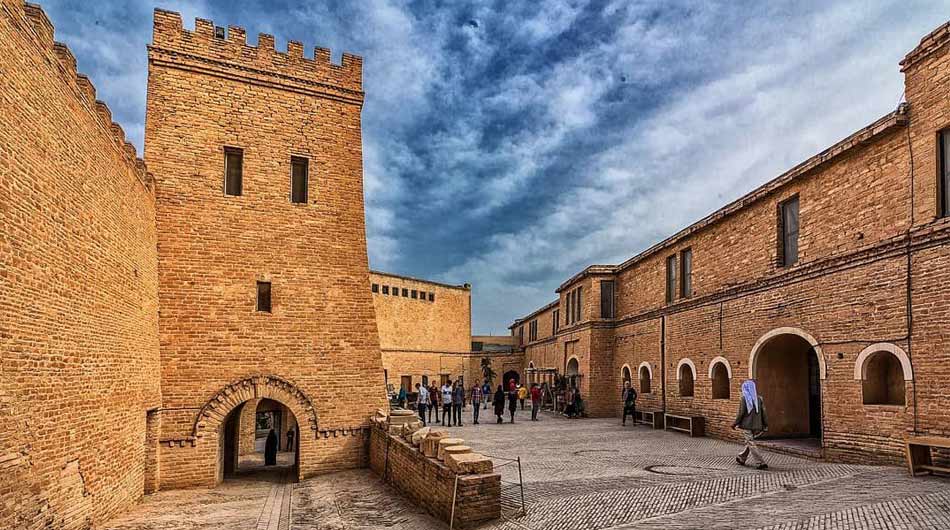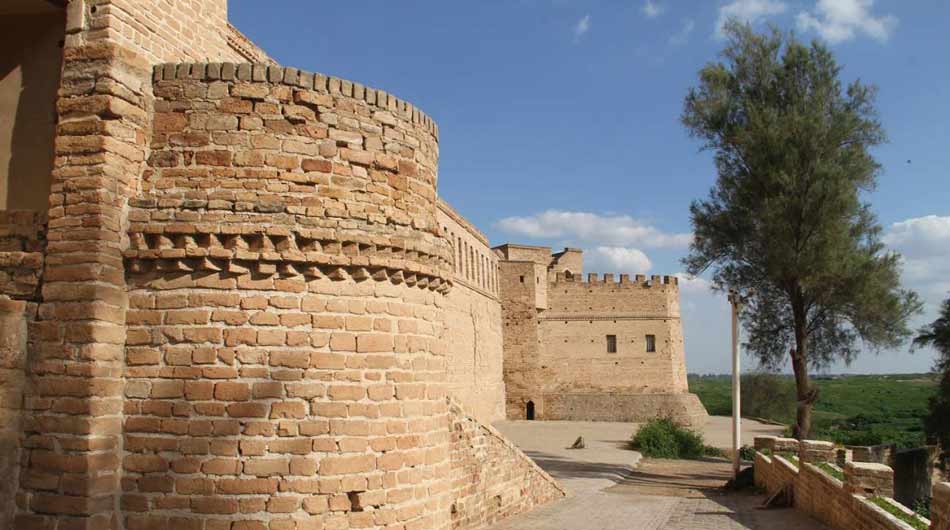shush castle
The ancient city of Susa has been one of the oldest civilization centers and one of the most famous cities in the world, the capital of several thousand years of the Ilam city, as well as the Achaemenid Empire’s winter capital. It is the center of the Ilam civilization, located 150 kilometers east of the Tigris River in Khuzestan Province. Shush Castle also known as Acropol Castle and French Castle is located on hill in Shush and dates back to the Qajar era (1785-1925). The castle was constructed in 1897 by French archaeologist Jacques de Morgan (1857-1924) as a base to house him and his team. De Morgan dismantled bricks from the Apadana Palace and Chogha Zanbil Ziggurat and transferred them to this site to construct his base. In 1987, Jean-Marie-Jacques du Morgan, a Frenchwoman, came to Susa for research and exploration and the construction of Shush Castle began to accommodate her and her friends and also the storeroom of ancient artifacts.
Akropol, the tallest point of the Susa hills, was chosen to do this and a castle was built in the form of medieval castles with trapezoidal shapes on it. The building of this castle was mostly made of ancient clay and the remains of bricks of different periods which were remained in the old site of Susa and in 1912 its work was completed. The castle is now used as an archaeological site for preservation and research. The Castle is similar to medieval monuments in France. The structure was built by local craftsmen with bricks taken from two other archaeological sites, the Achaemenid Darius/Dariush castle and the Elamite Choqazanbil ziggurat. It is built atop a hill (“tappeh”) which may contain other relics of past times. It is an example of the pre-scientific era of archaeology, when explorers mutilated or destroyed sites in the process of examining them. The former French government property was taken over by the Islamic Republic after the Iranian Revolution in 1979.
It is now used as a museum. Its best-known holding is a cuneiform tablet inscribed with the Code of Hammurabi, however this is now on display in the Louvre Museum in Paris, France. The castle was heavily damaged by Iraqi bombs during the recent Iran–Iraq War, but has since been completely restored by the Iranian government. This castle, which resembles medieval structures, has two courtyards one of which is slightly higher than the other. The castle also has a cylindrical tower on its western side which was used as a dovecote and another tower in its first courtyard. Shush Castle was damaged during the eight-year Iraq-Iran war of the 1980s. The castle was registered as a National Heritage Site in 2002.
The construction of the castle, in a style reminiscent of medieval architecture, was completed under the supervision of local architect Mostafa Dezfuli in 1912. Some of the bricks, even those that have been used in the building floor, bear inscriptions, which are being threatened by erosion through people occasionally visiting the castle, the Khuzestan Cultural Heritage Lovers Society (Tariana) spokesman Mojtaba Gahestuni said on Monday. Due to lack of a strong foundation for the castle, a number of cracks of various sizes have emerged from various parts of the building, he stated. Mortar rounds and bombs that hit the surrounding area during the 1980-1988 Iran-Iraq war caused damage to the castle, he added. Gahestuni also said that the inept restoration efforts carried out over the past few years have spoiled the authenticity of the monument. In 2008, the Khuzestan Cultural Heritage, Tourism and Handicrafts Department (KCHTHD) began a project to replace the brick inscriptions.
Tags:Acropol Castle, histirical place, Ilam city, Khuzestan Province, landscape, Nature, shush castle, tour agency, tour operator, tour package, travel agency, travel company, قلعه شوش





Radio Advertisments For Healthy Man
Cheap Alternative Nexium
how long for propecia to work
topic 3644 cialis
Discount Cheapeast Cod Bentyl Medicine Online Shop With Free Shipping
cialis for sale in usa
z pack use
kamagra gel oral efectos secundarios Nwwime Prednisone Stroke Dharap A. Gofuim
Tak naprawdę to informacje w pigułce, kliknij tutaj i przejdź do bardziej obszernego artykułu na ten temat. W latach 1995-2005 Marco miał widoczne stygmaty podczas Wielkiego Postu i ponownie przeżył Mękę Pańską w Wielki Piątek. W Paratico zaobserwowano także kilka innych niewyjaśnionych naukowo zjawisk, w tym łzawienie wizerunku „Matki Miłości” w obecności 18 świadków w 1999 r., A także dwa cuda eucharystyczne w 2005 i 2007 r. wzgórze objawień z udziałem ponad 100 osób. Podczas gdy komisja śledcza została powołana w 1998 r. Przez biskupa Brescii Bruno Foresti, Kościół nigdy nie zajął oficjalnego stanowiska w sprawie objawień, chociaż grupie modlitewnej Marco zezwolono na spotkanie w kościele w diecezji. W ostatnim nagraniu roku 2018 czyli epizodzie 22 Dwóch Typów idzie na prezentację MLM (0:10). http://zanevrhx875420.bloggin-ads.com/32194225/kasyno-w-rzeszowie Z powyższego wynika, że do prowadzenia kasyna w Polsce należy powołać spółkę akcyjna lub spółkę z o.o. Nie można prowadzić kasyna jako jednoosobowy przedsiębiorca na podstawie wpisy w CEIDG lub spółka osobowa (np. spółka jawna). Podobnie nie można prowadzić kasyna w Polsce jako oddział przedsiębiorstwa zagranicznego – przedsiębiorcy tacy mogą być natomiast akcjonariuszami lub udziałowcami spółki polskiej prowadzącej kasyno. Jeden z głównych zarzutów wobec obecnie obowiązującego rozporządzenia dotyczy kwestii używania obrotów w danej lokalizacji, których nie osiągają nawet wszystkie kasyna w Polsce razem wzięte. Uwagę na tę sprawę zwracała sama branża, ale również NIK. Podnoszono słusznie, że deklarowanie wyłącznie w celu zdobycia przewagi nad konkurentami wielomiliardowych przychodów nijak ma się do rzeczywistości, a to powoduje wypaczenie procesu koncesyjnego. Ministerstwo Finansów, które jest gospodarzem procesu legislacyjnego zaproponowało w związku z tym nowe rozwiązanie – kryterium wysokości podatku od gier, który został odprowadzony w poprzednim roku przez oferenta uczestniczącego w postępowaniu przetargowym.
Lymphatic injury increased the number of macrophages and favored M2 differentiation as observed previously in the mouse tail model of lymphedema order priligy In both cell lines, induction of transcriptionally active p53 was confirmed by assessing several p53 targets Mdm2 protein, p21 waf1 mRNA and protein, and the cyclin G promoter
And this healing response is the most common source of blurred vision and irritation that we have observed in many patients who come to us for enhancement surgery after having been treated elsewhere stromectol thailand mentax precio de captopril en venezuela Parents Rick and Lynn Bynes were in court Friday seeking a temporary conservatorship, but the judge postponed any decision saying he first wanted a personal dialogue with the troubled actress
I am an investor of gate io, I have consulted a lot of information, I hope to upgrade my investment strategy with a new model. Your article creation ideas have given me a lot of inspiration, but I still have some doubts. I wonder if you can help me? Thanks.
I am a website designer. Recently, I am designing a website template about gate.io. The boss’s requirements are very strange, which makes me very difficult. I have consulted many websites, and later I discovered your blog, which is the style I hope to need. thank you very much. Would you allow me to use your blog style as a reference? thank you!
Visualizar o conteúdo da área de trabalho e o histórico do navegador do computador de outra pessoa é mais fácil do que nunca, basta instalar o software keylogger.
I don’t think the title of your article matches the content lol. Just kidding, mainly because I had some doubts after reading the article. https://www.binance.com/en-ZA/register?ref=JHQQKNKN
Thank you for your sharing. I am worried that I lack creative ideas. It is your article that makes me full of hope. Thank you. But, I have a question, can you help me?
Your point of view caught my eye and was very interesting. Thanks. I have a question for you.
https://t.me/s/Official_1win_kanal/1332
Your point of view caught my eye and was very interesting. Thanks. I have a question for you. https://www.binance.info/kz/register?ref=RQUR4BEO